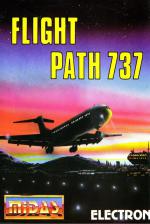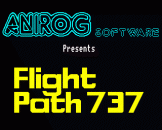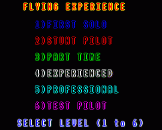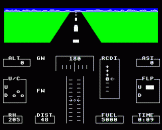Introduction
As the pilot of this high performance jet airliner, you must take off from an airfield surrounded by high mountains and having climbed your aircraft safely over them, prepare yourself and the jet for a landing at an airfield in the valleys below.
Taxi for take off: Press F1 and you will star to taxi at 20 knots. Note the runway heading (RH) and turn the aircraft to line up on the ryunway, which will then be in front of the cockpit window. Put the FLAPS DOWN for take-off, and increase speed to at least 180 knots but not more than 200 knots because the flaps will be damaged.
Take off and climb: Pull the joystick back and the jet will take-off. Once you are above 300 feet, you may retract the undercarriage (A) and flaps (F). When you rase the undercarriage on an aircraft, the speed will increase by 5 knots, so you must be careful at this phase not to exceed the maximum flap down speed (200k). Remember that with the flap up, there is a new (higher) stalling speed (180l), so do not let the aircraft come below this in flight or you will stall.
Climb: Having raised the undercarriage and flap, you may increase speed and climb to at least the height of the mountains shown in the level selected earlier. A red high Ground Warning light will flash as you approach the mountains, and will go steady red when you are afely above them. When this light goes out you are clear to descend for landing.
Cruise: During your short cruise over the mountains, the Runway Heading iwll flash telling you the new runway heading for ladning. (It's different every flight - so beware!)
Descent: With the ground warning light out,at 25 miles to touchdown, push the joystick forward, to descend towards the runway. The speed will increase as you dive so keep this under control.
Approach to land: At 10 miles to touchdown, a light will appear on the runway. If this is white, you are high for landing, if red you are too low and if green, you are about right.
You must have the saps and undercarriage down above 300 feet, again observing the maximum and minimum speeds for their operation.
Don't forget that lowering the undercarriage reduces speed by 5 knots.
Landing: Keep the speed between 160 (stalling speed with flaps down) and 170k and when the distance shows 0 (not before), bring the aircraft down to zero altitude. As soon as you see zero altitude, pull the joystick back to fly level and you have landed. Press R for reverse thrust and press F7 rapidly to bring the speed back to less than 20k. You must stop before the end of the runway whose length (indicated by minus distance) you will have been told in the skill level selection.
Score: If you make any errors in your aircraft handling you will be told exactly where you went wrong. If you land successfully, a score will be given, together with advice on whether to proceed to the next level. The faster you fly - the higher your score.
Fuel: You will always have just enough fuel for one attempt at landing on each flight.
Speed
| F1 | +20 KN |
| F3 | +10 KN |
| F5 | -20 KN |
| F7 | -20 KN |
Notes: The higher the level you select, the quicker you must climb the aircraft from the moment of lift-off. Use the Rate of Climb indicator and the best climb speed (420k) to clear the montains and keep your wits about you. The screen of successful flying is to think ahead. Stay clam and you will live to fly again!
Game Controls
| Right | - | X | + 20 Knots | - | 7 | |
| Left | - | C | + 10 Knots | - | 4 | |
| Up | - | : | - 10 Knots | - | 1 | |
| Down | - | / | - 20 Knots | - | 0 |
Please ignore all reference in this inlay to joysticks or F keys.







